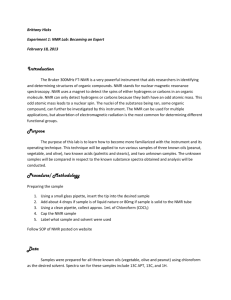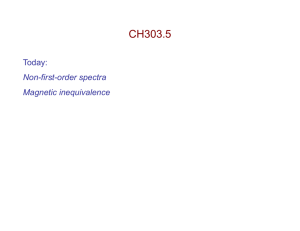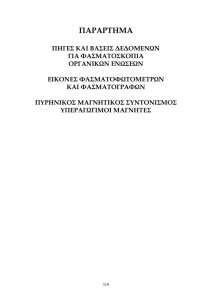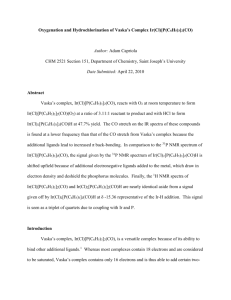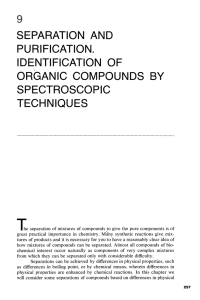Inorganic Spectroscopy
advertisement
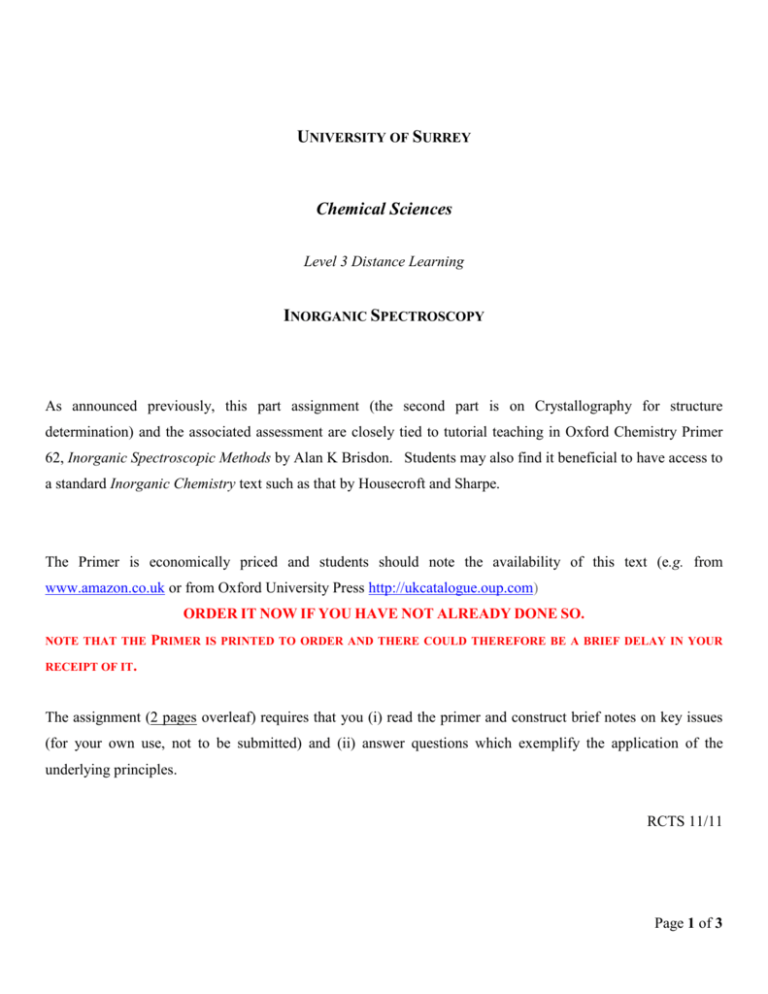
UNIVERSITY OF SURREY Chemical Sciences Level 3 Distance Learning INORGANIC SPECTROSCOPY As announced previously, this part assignment (the second part is on Crystallography for structure determination) and the associated assessment are closely tied to tutorial teaching in Oxford Chemistry Primer 62, Inorganic Spectroscopic Methods by Alan K Brisdon. Students may also find it beneficial to have access to a standard Inorganic Chemistry text such as that by Housecroft and Sharpe. The Primer is economically priced and students should note the availability of this text (e.g. from www.amazon.co.uk or from Oxford University Press http://ukcatalogue.oup.com) ORDER IT NOW IF YOU HAVE NOT ALREADY DONE SO. NOTE THAT THE PRIMER IS PRINTED TO ORDER AND THERE COULD THEREFORE BE A BRIEF DELAY IN YOUR RECEIPT OF IT. The assignment (2 pages overleaf) requires that you (i) read the primer and construct brief notes on key issues (for your own use, not to be submitted) and (ii) answer questions which exemplify the application of the underlying principles. RCTS 11/11 Page 1 of 3 The maximum mark that can be gained is 50/50. Start each whole question on a new page. Read each question carefully – the questions relate to coverage in the Brisdon Primer but require you to apply more widely the knowledge and insights that you will be gaining. High resolution NMR in the study of solutions of inorganic compounds. [use splitting diagrams where appropriate] 1. Answer all parts. (a) In what ways do the NMR spectra recorded for quadrupolar nuclei (I > ½) differ from those recorded for spin-1/2 nuclei? What are isotopomers ? [4] [Isotopomers: Note that the common usage (which you should adopt both in this question and in question 5) involves any isotopic substitution (e.g. 10BH4- and 11BH4-), but that a more restrictive definition is used by Brisdon (that isotopomeric molecules/ions must have the same relative mass)] (b) What are the splitting rules for coupling of a nucleus to n equivalent heteronuclei with (i) I = ½ and (ii) I > ½. What is Pascal’s triangle when can it be applied in predicting splitting patterns ? [3] (c) Explain how the NMR spectrum of a compound can be temperature dependent. [4] [You will find it helpful to consider the timescales of spectroscopic experiments, stereochemical non-rigidity (fluxionality) and the effects of temperature on rate processes] 2. Answer all parts. (a) Explain in detail how the 11B NMR spectrum of [BH4]- is a 1:4:6:4:1 quintet while the 1H NMR spectrum of [10BH4]- is a sequence of 7 lines with equal intensities and equal spacings. [4] (b) The 1H NMR spectrum of [H2P2O5]2- can be described as a doublet of doublets of doublets. Discuss the origin of this 1H NMR spectrum and its detail. [4] (c) Discuss how the Berry mechanism of ligand exchange can lead to temperature dependence of the 31P NMR spectra of the ions [Rh(PR3)5]+. What are the limiting forms for the spectra observed at (i) low temperature and (ii) high temperature? [4] Optical spectroscopy of inorganic species Page 2 of 3 3. Answer all parts. (a) Explain the nature of vibrational group frequencies and their importance in the investigation of inorganic materials in which such vibrations can be considered independent of each other. [3] (b) In what ways are the findings of infrared and Raman spectroscopy complementary? Why for carbonyl compounds do these spectroscopies commonly give information about differing aspects of the binding of carbon monoxide ligands? [3] [You will find it helpful to consider the selection rules applying to these 2 spectroscopies, these being consequent on the differing phenomena leading to definition of a “frequency” (cm-1) axis in each case. You should consider which bond(s) (metal to carbon, carbon to oxygen) in a carbonyl compound each spectroscopy is powerful in detecting.] (c) Compare and contrast the phenomena that lead to the spectrochemical series and the nephelauxetic series for ligands, both of which result from observation of UV-visible spectra of transition metal complexes. [4] 4. Answer all parts. (a) Why do the infrared spectra for compounds cis-[PtCl2(PR3)]2 contain 2 IR-active Pt-Cl stretches and 2 IR-active Pt-P stretching vibrations? [3] [4(a) differs from 3(a) in that coupled vibrations are now present.] (b) Explain how the infrared spectra of gases contain much more detail than those of solids. What are P, Q and R branches? [3] (c) What are charge-transfer transitions and what is meant by optical electronegativity? [3] (d) Why is a dilute solution containing [Mn(H2O)6]2+(aq) very pale pink whereas a similarly dilute solution containing [MnO4]-(aq) is an intense purple colour. [2] Mass spectrometry of inorganic molecules 5. Answer all parts. (a) Discuss the observed sequence of evenly spaced peaks in the electron ionisation mass spectrum of a mononuclear iron carbonyl compound. [3] (b) Discuss and illustrate the complications that can arise in the mass spectra of molecules that have isotopomer (which differ only in the positions of isotopes or the isotopes present). [3] Page 3 of 3



